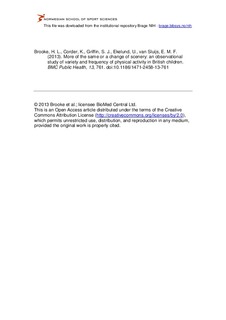| dc.contributor.author | Brooke, Hannah L. | |
| dc.contributor.author | Corder, Kirsten | |
| dc.contributor.author | Griffin, Simon J. | |
| dc.contributor.author | Ekelund, Ulf | |
| dc.contributor.author | van Sluijs, Esther M. F. | |
| dc.date.accessioned | 2014-03-14T09:35:48Z | |
| dc.date.available | 2014-03-14T09:35:48Z | |
| dc.date.issued | 2013-08-16 | |
| dc.identifier.citation | BMC Public Health. 2013, 13, 761 | nb_NO |
| dc.identifier.uri | http://hdl.handle.net/11250/191606 | |
| dc.description | © 2013 Brooke et al.; licensee BioMed Central Ltd. | nb_NO |
| dc.description.abstract | Physical activity is important for children’s health, but successful physical activity promotion is challenging. Whether performing many different types of activities (Variety) is associated with higher physical activity independent of the number of activity sessions (Frequency) is unknown, but this information could inform physical activity promotion and public health strategies in children.
Methods: In the SPEEDY study we measured moderate-to-vigorous intensity physical activity (MVPA; ≥2000 counts/minute) over 7 days using GT1M Actigraph accelerometers in 1700 children from Norfolk, UK (56% girls, Mean ± SD 10.3 ± 0.3 years-old). Children reported participation in 28 leisure-time activities over the previous 7 days. Sex differences in activity participation were assessed using multilevel logistic regression, clustered by school. Associations of log-transformed MVPA with z-score-Variety (number of different activities/week) and z-score-Frequency (sum of all activity sessions/week) were examined using multilevel linear regression, adjusted for age, sex, parental education and age-standardised BMI.
Results: Children’s activity participation often reflected gender stereotypes. Mean ± SD Variety was 10.8 ± 5.0 activities/week, and Frequency was 24.2±15.0 sessions/week. In separate models lnMVPA had similar strength, positive associations with z-score-Variety and z-score-Frequency (Exp β(95% CI); Variety 1.04(1.02-1.06), Frequency 1.04(1.02-1.06)). lnMVPA was not associated with z-score-Variety independent of z-score-Frequency (Variety 1.01(0.98-1.04), Frequency 1.03(1.00-1.06)).
Conclusions: Future physical activity interventions and public health strategies could allow for gender specific activity preferences and could target both Variety and Frequency of activities participated in by children. | nb_NO |
| dc.language.iso | eng | nb_NO |
| dc.publisher | BioMed Central | nb_NO |
| dc.subject | VDP::Medisinske Fag: 700::Helsefag: 800 | nb_NO |
| dc.subject | children | nb_NO |
| dc.subject | physical activity | nb_NO |
| dc.subject | accelerometer | nb_NO |
| dc.subject | primary school | nb_NO |
| dc.subject | intervention | nb_NO |
| dc.subject | public health | nb_NO |
| dc.title | More of the same or a change of scenery: An observational study of variety and frequency of physical activity in British children | nb_NO |
| dc.type | Journal article | nb_NO |
| dc.type | Peer reviewed | nb_NO |
| dc.source.journal | BMC Public Health | nb_NO |
| dc.identifier.doi | 10.1186/1471-2458-13-761 | |
| dc.description.localcode | Seksjon for idrettsmedisinske fag / Department of Sport Sciences | nb_NO |
